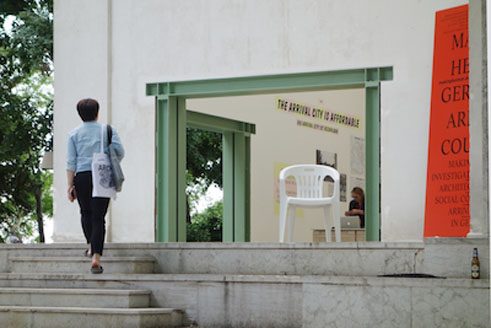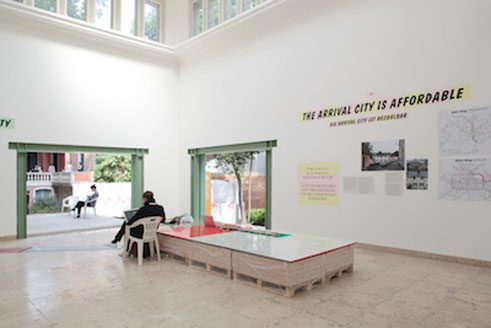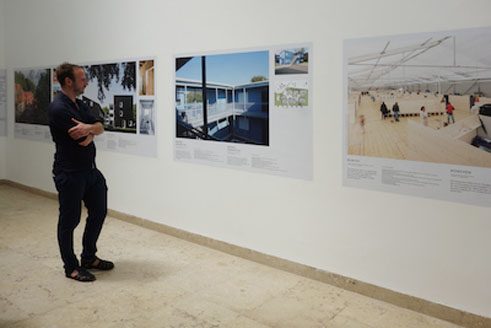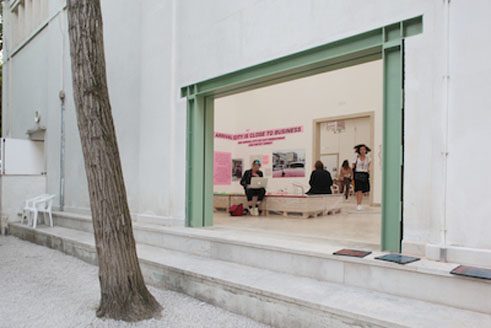Architecture Biennale
An Open House – The German Contribution at the Architecture Biennale in Venice

The team of the German Museum of Architecture (Deutsches Architekturmuseum/DAM) in Frankfurt formulated a manifesto with eight theses on how the integration of highly diverse cultures into German society can succeed.
Just in 2015, roughly one million refugees and migrants from Syria, Afghanistan, the Balkans and North Africa arrived in Germany to make a new homeland for themselves. »Making Heimat. Germany, Arrival Country« is the title with which the team of the German Museum of Architecture had submitted the German contribution to the 2016 Architecture Biennale in Venice. The curators had actually intended to present “Best Practice” examples of refugee accommodations. But instead of this they formulated a manifesto with eight theses on how the integration of highly diverse cultures into German society can succeed.
Chilean Pritzker Prize award winner Alejandro Aravena had specified his main exhibition, »Reporting from the Front«, with 88 contributions by a wide range of architectural teams and the 63 national pavilions. Last autumn, images of refugee inflows had dominated the news for weeks. These scenes of a state of emergency unaccustomed in Germany moved director Peter Cachola Schmal, curator Oliver Elser and project coordinator Anna Scheuermann of the German Museum of Architecture/DAM to submit their long-planned project to the Architecture Biennale in order to position it within a global context of discourse.
Improvisation as concept
 Photo: Frank Kaltenbach
Photo: Frank Kaltenbach
Stackable white plastic chairs from the DIY supermarket, used laminated panels and still-wrapped Euro-pallets with bricks welcome the visitor. On the walls are mainly small-format posters, printed with simple A3 printers and directly glued to the walls with spray adhesive. Instead of German beer, one stand offers Ayran, a traditional Turkish yogurt drink as free refreshment. Admittedly, compared with the many perfectly-styled pavilions of other countries, the exhibit in the German pavilion comes across as cheap and improvised. But that is precisely its programme, since that is the aesthetic and the attitude towards life of the so called Arrival City, as it exists everywhere in the world as a global phenomenon of migration, and as Canadian journalist Doug Saunders described it in his bestseller »Arrival City – the Final Migration and Our Next World«. In addition to Kai Vöckler of Offenbach, Saunders is also serving as consultant for this contribution to the Biennale.
Arrival City in Germany
 Photo: Frank Kaltenbach
Photo: Frank Kaltenbach
In 2013 Saunders’ book was published in a German edition with the title »Die neue Völkerwanderung, Arrival City«. In 2015 the situation of the refugee crisis was radically exacerbated both along the Balkan route and in Germany. How could affordable housing be created as quickly as possible for so many new arrivals? The curators issued a call for projects and compiled all entries involving current initial reception points and accommodations into a data bank. The few architecturally outstanding examples are also presented in the exhibition with photos and flyers.
But first and foremost the curators wish to inspire confidence and present positive examples of where and why the integration of highly diverse cultures is already functioning in German society: thus Offenbach with 30 percent is the German city with the highest percentage of foreigners nationwide, and whose arrival district Nordend reaches 48 percent. This is almost double the percentage in Neukölln, the arrival district of the capital city of Berlin, whose ground-level zone with its international shops and restaurants is posted on the walls of the central hall in the photographs of Florian Thein. The surprising message: seen from without, Arrival Cities seem like run-down, troubled neighbourhoods. But upon closer examination, they offer new arrivals exactly what they need. The curators summarise the conditions for the success of an Arrival City in eight theses, each of which thematises one wall as heading:
1 The Arrival City is a city within the city
2 The Arrival City is affordable
3 The Arrival City is readily accessible and provides employment
4 The Arrival City is informal
5 The Arrival City is built on a DIY basis
6 The Arrival City is on the ground level
7 The Arrival City is a network of immigrants
8 The Arrival City needs the best schools
An open house for all
 Photo: Frank Kaltenbach
Photo: Frank Kaltenbach
Nonetheless, the main attraction is the four large openings that exhibition designer Something Fantastic broke into the outer walls of the historic pavilion from 1909 to transform the closed-off, landmarked building into a space of possibilities open on all sides. They had 48 tonnes of brick broken out. To reassure the landmark agency that the openings will be bricked up and the temporary green steel girders disappear once again, they have integrated into their scenography the necessary number of bricks as bases for tables and counters.
 Photo: Frank Kaltenbach
Photo: Frank Kaltenbach
Through the newly opened gateways to the neighbouring pavilions and to the lagoon, the events in the German pavilion are characterised by a surprisingly refreshing wind of cultural interaction and community that hopefully will also waft into the social-policy debates on the refugee crisis throughout Europe.